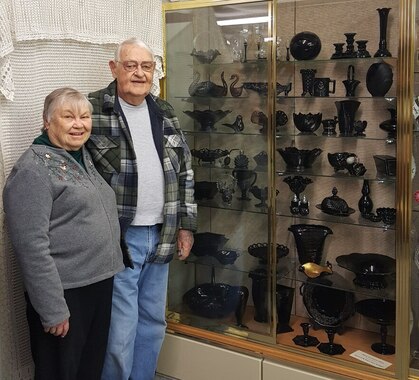By Kathlyn Hofmann Richard and Mary Ann Azinger’s collection of Black Glassware has found a new home in our museum. Richard’s parents, Herman and Loretta Azinger, bought some etched stemware on their honeymoon to New Orleans in 1931. The two pieces pictured here are part of the original set which Azingers kept. They recently moved to Waukee and although they kept a number of their favorites, they couldn’t keep all of the more than 1000 pieces collected over many years. They are pictured below with some of the items now on display. We hope to switch them out over time, so that visitors can enjoy them. The invention of black glass dates back to 17th century Italy. Originally used for bottles, the addition of iron oxide made the glass darker and stronger. The thick, dark bottles protected the contents (usually beer, wine, medicines, and other liquids) from spoiling due to exposure to light. Black Glass is actually a description of a type of colored glass. It has the look of solid black, but there is a surprise in this glass. When it is held to the sun or a strong light, color can be seen through it. The most common color is deep purple which is called Black Amethyst. It can also show red, gold, gray, green, blue or grape. This latter color is a pinkish purple shade. The colors are the result of the adding a combination of iron, copper, and cobalt oxide during production. It is very difficult to see color through the thick items. This is especially true of the solid glass animals. Black glass was made by many glass houses in America as well as in foreign countries. That often makes it difficult to identify. Pieces range from very old to brand new. A few of these companies went bankrupt, some failed to keep records or they were lost in fires. Also, the molds were loaned out or sold. Each glass house had its own formula for making black, so some glass will show a different color. The glass was sometimes decorated in a variety of ways using enameling, silver, gold, or a heavy sterling silver deposit. It was also etched and sometimes given a satin finish. This was done either by the glass house or by firms specialized only in decorating. Richard and Mary Ann moved to DeWitt in 1965 when Richard took a job teaching remedial reading. He worked for 36 years, mostly with first and second graders. Mary Ann worked at West Wing and also baby sat. They built their collection over many years, piece by piece and set by set. They went to antique stores in the towns where their four sons and daughter were competing in sports events. When on vacation, they were always looking for new pieces. “It’s the thrill of the chase,” Richard said. “That’s what it’s all about.” Sources: Black Glass, An Illustrated Price Guide, by Margaret James. 1981 Collector Books, Paducah KY https://journalofantiques.com/features/black-glass-beautiful-functional/ Comments are closed.
|
